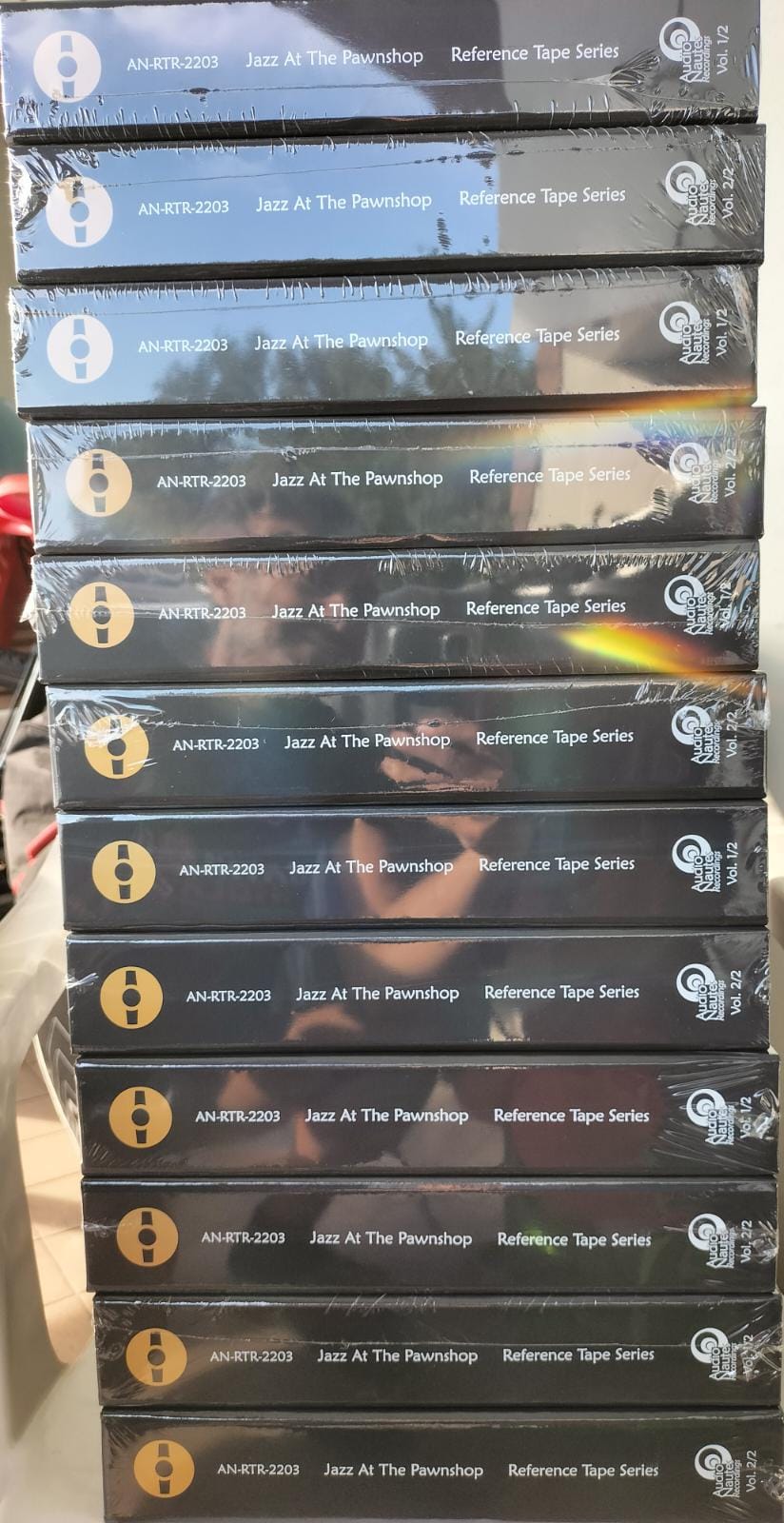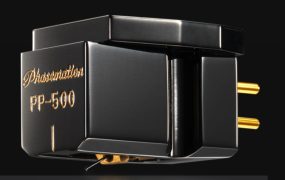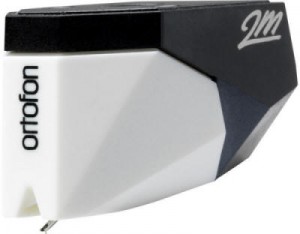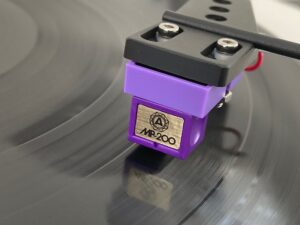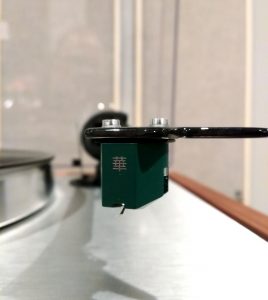So much for the Japanese tradition of honoring your ancestors! The simply stunning looking and even better sounding blue stone body Azule Platinum moving coil cartridge bears little or no resemblance to the Koetsu cartridge your father owned. Moreso, any sonic similarity—or even familial resemblance—between the current Azule Platinum and the Koetsu Rosewood Signature cartridge that I reviewed 15 years ago for Ultimate Audio is purely coincidental.
In fact, the sound of the blue bodied Azule Platinum was so totally unlike any other Koetsu in past memory that I was speechless. (It was hearing this cartridge set-up in the Doshi Audio rooms at RMAF that initially prompted my request for a review sample.) Speaking of words, when was the last time anyone described a Koetsu cartridge as neutral, dynamic, fast, resolving, not to mention having tight bass and pure and extended upper octaves? Certainly not me.
Make no mistake. This stone body cartridge isn't technicolored, warm, honeyed or syrupy like the Koetsu cartridges of yore. Sure, you can take it to the bank that some long time, dyed-in-the-wool, Koetsu purists will undoubtedly whine about the sound of this new stone body cartridge. But for those intimately familiar with the sound of live music, the new Azule Platinum is unquestionably a major step forward. Unlike past efforts, the Azule Platinum doesn't sugar coat the music nor does every recording sound the same or pretty. What you hear is what you get. Take for example Pure Pleasure Records' reissue of Lightnin' Hopkins in New York (Pure Pleasure/Candid 9010). At first blush, this recording is a fairly respectable sounding reissue. The Koetsu instantly reveals, however, in comparison to a third generation, 15-ips tape copy of the original recording that the reissue is washed out and suffers from a significant loss of spatial and musical information and midrange palpability. Almost as if Pure Pleasure cut the reissue not from the original master tape but a safety copy (not to mention DMM mastering). On the other hand, comparisons between say the Tape Project's 15-ips tape release and Analogue Productions 45 rpm LP reissue of Bill Evans Waltz for Debby (or other tape/LP pairings) yielded far closer sonic results.
Going Prospecting
Once upon a time Koetsu cartridges represented the pinnacle of analog playback. Their mere mention brought oooohs and awwwws and deep bows from the audiophile brotherhood. Sadly though, Koetsu cartridges disappeared for the most part from the high-end audio scene for the better part of the last decade after then US distributor Musical Surroundings (with a side order of Art Manzano of AXISS Audio) dropped the line. The good news is, however, that distribution of the Koetsu line has been resurrected and is back in the capable hands of Jaime Monroy who formerly worked for Musical Surroundings, Sumiko and several other high-end audio companies.
Koetsu the company, also underwent some internal changes during this period. Sadly, the company's founder and original designer Sugano Yoshiaki passed away in 2002. But before he died, Yoshiaki worked with and passed his knowledge onto his son Sugano Fumihikoand it's his heir's vision that has shepherded the company into its fourth decade of manufacturing handmade phono cartridges. To this day, Koetsu remains a family owned and operated business with Fumihiko involved in every aspect of the company's day-to-day operations including the building, sourcing and scheduling of the manufacturing process.
A Rock Solid Performer
The new Koetsu Azule Platinum bridges the best of both musical dimensions. Yoshiaki Sugano, the patriarch of the Koetsu family, strove when designing his cartridges, "to create an emotional connection to the playback of the recorded event (the record) and to engage the listener, to draw them in and allow them to "feel" what they are hearing." But clearly these older cartridges are by today's—or any day's standard—highly colored. If only music sounded like this! Son Fumihiko has on the other hand, taken his father's original design and elevated it to the next level in the Azule Platinum. This new cartridge is a far more evenly balanced performer throughout the musical spectrum while at the same time retaining that ever-so-elusive musicality (a quality that for instance, that the ZYX Universe II has in spades). Gone in this new stone body cartridge are those oh-so pleasant distortions that gave the older Koetsus their softer, lusher and mushier character and limited frequency extension (in retrospect, those coloration may have been a blessing in disguise, not to mention a neat tone control, in those days of ringing tonearms and bright electronics). By contrast, the Azule Platinum is an exceedingly neutral, tipping if anything just ever-so-slightly to the yang side of things, sounding cartridge.
What really sets the Azule Platinum apart from other cartridges is its absolutely effortless, tape-like dynamics from top to the bottom of the music spectrum. Unlike older Koetsus, the new Azule Platinum is truly an exciting cartridge with appeal to not only classical and jazz listeners but also rock lovers. Take for example that old fallback reference album Elvis '57 (RCA/Analogue Productions 057-45). What's especially striking about this spooky old rough cut played back with the Azule Platinum is the recording's unbridled, uncompressed dynamics and the tonality of Elvis' voice. Elvis' voice is simply silky smooth but without any corresponding loss of information. The Jordanaires more than ever really underpin the music. Even more impressive is just how the cartridge reconstructs both the sense of Elvis' being in the recording studio as well as coalescing the outline of his body. There's just an uncanny feeling of a head being atop a real body. Finally with proper attention to loading and geometrical alignment, there's none of that oh-so-typical sloppy and ill-defined bass of the older Koetsus on "Peace in the Valley." While the Azule Platinum's bass performance might fall just slightly short of ultimate, we're honestly nitpicking at this point.
Gregorio Paniagua's mad and crazy interpretation of early Spanish Dances on La Folia(Harmonia Mundi/ATR Mastercut 013) proves another challenging test for all but the stoutest transducers. While La Folia might not be the first recording that comes to one's mind when it comes to dynamics, don't be fooled. For instance on side one, travel slightly north of the Pink Panther snippet to where in all the craziness of this recording, one of the performers throws and breaks/wastes a bottle of bourbon. Anchored by the Koetsu and with the simply effortless sounding Audia Flight Strumento No. 4 solid-state amplifier from Italy (see upcoming video review at AVShowrooms.com) driving the Magico S5s, the system is absolutely unfazed by the bottle's impact and explosive blast. Or take the dynamic energy of the dueling Jew's harps where you can literally feel the instruments vibrating. Furthermore, the Azule Platinum has no issues handling he most complex and densely orchestrated musical passages on this album.
It doesn't just stop there either. Another area that gets my juices flowing is the Koetsu's ability to recreate the ambience of the original recording space on La Folia. The Azule Blue simply throws a tremendous soundstage particularly when it comes to depth. Just listen to the bells floating in space. Just listen to the purity, extension and decay of the bells. Just listen to the airiness of the recording space. There's a subtlety to the tambourines and harpsichords that escapes many other cartridges. All these qualities just serve to bring the listener one big step closer to the actual recording.
Koetsu and midrange magic are synonymous and the new Azule Platinum certainly doesn't disappoint (save for the lack of the obvious coloration of the older models). Trumpets, saxes and especially guitars are simply spectacularly rendered. There is just something really special about how the Koetsu reproduces the sounds of all-star jazz guitarists be they be acoustic or electric variety or the likes of Kenny Burrell, Barney Kessell, Wes Montgomery, George Benson or in this case Bola Sete on his '63 release tour de force (Fantasy Records 8358). Sete, a Brazilian born jazz guitarist at the forefront of the bossa nova revolution in the US, is front and center on the simple trio recording. The center image is so solidly defined, so wrap around dimensional and so realistic that it feels like Sete is in the room. The Koetsu really captures the essence of Sete's guitar: its lightness, feeling of overtones and air (that is oh-so rarely captured on any guitar recording) as well as his amazing virtuosity. One can literally can feel Sete's fingers caressing and controlling each string.
Or drop a copy of Art Farmer's Portrait of Art Farmer (Contemporary S7555) on the platter. (All LP collectors are renowned for periodically going shopping for records on their shelves and this album was one recently discovered gem!) Released the year Farmer was voted New Star of the Year in the Downbeat magazine poll, he assembled an absolutely amazing quartet on this album featuring the likes of Roy Haynes on drums and Hank Jones on piano along with Art's brother Addison on bass. (Interestingly, this is one of the few Contemporary recordings that I've run across without any attribution to Koenig and DuNann. The best explanation I could come up with [thanks to input from Steve Hoffman] was that this recording was done at Beltone Studios in NYC?) On Farmer's composition "Back in the Cage," not only is the smooth, warm tone of his trumpet in great evidence but the Azule Platinum captures much of the energy of the instrument. There's none of that softening of yesteryear's Koetsus. The icing on the cake is not only the recording's impressive sense of transparency, but the tone and timbre of the cup mute on Farmer's trumpet on the "The Very Thought of You."
Lastly, the frequency extremes—as previously noted in my Ultimate Audio review—were never a strong suit of Koetsus. Their low end was more often than not slow and mushy and the upper octaves were rolled off. Speed? (Some might say what speed?) The older Koetsus always sounded a beat or two behind the music. Now whatever Fumihiko has done (have to assume that much of these sonic improvements are due to Fumihiko tweaking the cartridge's tracking ability), the frequency extremes are markedly improved. The Azule Platinum cartridge sails through most of the torturous tracking tests like bells, triangles and xylophones. When was the last time you could say that about an older Koetsu cartridge? Throw something like Carlos Chavez'sToccata for Percussion Instruments (Super Analogue SSY19) on the turntable and there's plenty of low end impact, energy and control. Yes, the cartridge might fall a little short of ultimate when it comes to mid-bass dynamics but that's only relatively speaking to the best. While the Azule Platinum is still not quite as fast as say an Ikeda, Proteus or Atlas, the cartridge's performance ain't exactly chopped liver either.
Combining Beauty and Sound
The love for Koetsu cartridges always eluded me until the Azule Platinum. As I wrote in my Rosewood Signature review many years ago, one needed to sacrifice an awful lot just to have a little bit of midrange magic. In other words, the tradeoffs simply weren't worth it. On the other hand, the new stone body Azule Platinum is a totally different animal and is the first Koetsu that I would welcome with open palms into my system with zero reservations. The Koetsu Azule Platinum is, along with the Lyra Atlas, two of the finest cartridges that I've had the pleasure of listening to in my system.
Interestingly, perhaps even shockingly to some readers, both the Azule Platinum and Atlas are sonically very similar. Both cartridges are exceedingly neutral with perhaps the Atlas getting the nod when it comes to solidity, bass control, resolution and dynamic punch and the Koetsu topping the charts when it comes to soundstaging, spatial recreation and harmonic resolution. Both cartridges are excellent trackers and possess very pure and detailed upper octaves.
An absolute gem of a cartridge and one that I can recommend without any hesitation!
Technical Highlights
Jaime Monroy spent the last 13 years honing his craft working for some of the best "analog" distributors before finally deciding the time was right for him to take that leap of faith and start his own distribution company based around the iconic brand Koetsu. And Jaime wanted that company's logo to be, "a symbol that represented balance and analog in its purest form. That logo turned out to be the name pelotone that is an amalgamation of the French word for bunch or group (peloton) plus "e" meaning a group of notes or a group of tones. And that is," Jaime added, "what music is to me. A group of tones that communicate and stirs up emotion in listeners. There's something seriously wrong if your records don't make you tap a limb, smile or get teary eyed when listening to them."
Each stone body Koetsu is a work of art but as Jaime points out, "the 'stone body' models are more alike than different." Each stone body Koetsu (plus the Rosewood Signature Platinum) uses the same highly regarded, now legendary Platinum magnets; the only differences between the cartridges are: 1) the exterior stone bodies and 2) tighter tolerances and matching of the internal parts for the Coralstone and Platinum Lace. "In his inimitable wisdom," Jamie shared, "Sugano san Sr. had the foresight to not only use these medical-grade magnets in his top models but, to buy up the entire stock at the time for future use. These magnets are no longer made and are coveted by other cartridge manufacturers (see Lyra Olympus, for example). The Onyx and Jade stone body cartridges came first and the other gemstones followed."
Named in honor of legendary multi-disciplinary craftsmen Hon'Ami Koetsu (the symbols representing "light" and "pleasure"), Koetsu developed a near legendary status in the early days of high-end audio (of course that was after moving coil cartridges were allowed into the US due to patent infringement issues). Yoshiaki Sugano was truly at the forefront of specialized phono cartridges always using the highest purity magnets and wire. Jamie added Yoshiaki, "relied on 'nature' (rosewood, stone bodies and Urushi lacquered finishes) to touch up, to resonate with these parts and add texture, color and tone." Coupled with input from his son Fumihiko, he improved the cartridge's tracking ability as well as lowering groove noise in both the stereo and mono versions.
Lastly, being a family owned and operated business, Koetsu can support restoration rebuilds of their cartridges. Customers can rest assured that the cartridge they have enjoyed for years, can be rebuilt and supported by the family; not an OEM house that simply offers a trade in.
A couple of quick notes on cartridge set-up. Mounting and aligning the Azule Blue in the VPI 12-inch 3D arm wasn't particularly difficult even with the cartridge's somewhat shorter length cantilever. After all was said and done, the cartridge was tracked at 2.0 grams and loaded into the Doshi phono section at 75 ohms. Obviously loading is to a large part system dependent and to a secondarily upon the capacitance of the phono cable. That said, I started out loading the Azule Platinum at around 400 to 800 ohms (that essentially is unloaded) as was used at a couple of shows; suffice it to say, the sound was less than satisfactory. As a result, I ended up dropping the loading and switched back and forth between the 45-75-100 ohm setting on the Doshi phono stage. Loaded at 100 ohms, the Azule Blue lost a bit of its dimensionality and low end impact and tightness and at 45 ohms simply lost too much of the dynamics, life and speed. So in the end, the 75 ohm setting represented the best balance between these different qualities.
Importer: Pelotone, LLC.
Tel: (415) 335-2728.
Generator: Platinum magnet; Cantilever: Boron; Output: 0.3 mV. Internal impedance: 5 ohm; Weight: 13 grams; Price: $10,950. Rebuild price, all stone body cartridges: $4450.








